Under what conditions will the set of cosets form a group? That is, under what conditions will coset addition or multiplication be well-defined?
If H is a subgroup of a group G, I'd like to multiply two cosets of H this way:
![]()
Here's the problem. A coset like ![]() can be
represented by different elements: That is, I can have
can be
represented by different elements: That is, I can have ![]() where
where ![]() . Remember that a coset
. Remember that a coset ![]() is a set of elements, not a single element.
For example, if you consider cosets of the subgroup
is a set of elements, not a single element.
For example, if you consider cosets of the subgroup ![]() in
in ![]() ,
,
![]()
Both of these sets consist of all the odd integers, even though ![]() .
.
So in writing ![]() , I should be able to
replace
, I should be able to
replace ![]() with
with ![]() , since they're
equal. Then I'd get
, since they're
equal. Then I'd get
![]()
I should have ![]() , because the two cosets I
multiplied were the same in both cases. But how do I know this will
work? For that matter, what if I replace
, because the two cosets I
multiplied were the same in both cases. But how do I know this will
work? For that matter, what if I replace ![]() with
with ![]() , using a different representative
for the second coset?
, using a different representative
for the second coset?
It turns out that this doesn't work in general: I need to have a condition on the subgroup H.
Definition. A subgroup ![]() is normal if
is normal if
![]()
The notation ![]() means that H is a normal
subgroup of G.
means that H is a normal
subgroup of G.
Remark. (a) Since the statement runs over
all ![]() , I can replace "g" in
the definition with "
, I can replace "g" in
the definition with "![]() ", because
every
", because
every ![]() is the inverse of some element, namely
is the inverse of some element, namely ![]() ). Thus, I could just as well say "
). Thus, I could just as well say "![]() ".
".
(b) As usual, to check the set inclusion ![]() , you can verify that it holds for
elements: Let
, you can verify that it holds for
elements: Let ![]() and
and ![]() , and show that
, and show that ![]() .
.
(c) For a fixed ![]() , I have
, I have ![]() . But I also have
. But I also have

Hence, ![]() . So I actually have equality, not
just subset inclusion. If you're showing a subgroup is normal, you
are better off doing less work and just proving inclusion, as in the
definition: You get equality for free.
. So I actually have equality, not
just subset inclusion. If you're showing a subgroup is normal, you
are better off doing less work and just proving inclusion, as in the
definition: You get equality for free.
The next two results give some easy examples of normal subgroups.
Proposition. Let G be a group. Then ![]() and G are normal subgroups of G.
and G are normal subgroups of G.
Proof. To show that ![]() is normal, let
is normal, let ![]() . The only element
of
. The only element
of ![]() is 1, and
is 1, and ![]() . Therefore,
. Therefore, ![]() is normal.
is normal.
To show that G is normal, let ![]() and let
and let ![]() . Then
. Then ![]() , because g, h, and
, because g, h, and
![]() are all in G, and G must be closed under its
operation.
are all in G, and G must be closed under its
operation.![]()
Proposition. If G is abelian, every subgroup is normal.
Proof. If ![]() , then
, then ![]() .
.![]()
Example. ( Showing a subgroup
is not normal) Show that the subgroup ![]() of
of ![]() is not normal.
is not normal.
Here's the multiplication table for ![]() , the group of
permutations of
, the group of
permutations of ![]() .
.

I have to find an element ![]() such that
such that
![]()
There are several possibilities. For example,
![]()
Since ![]() , the subgroup
, the subgroup ![]() is
not normal in
is
not normal in ![]() .
.![]()
Example. ( A normal subgroup
of the quaternions) Show that the subgroup ![]() of the group of quaternions is normal.
of the group of quaternions is normal.
Here's the multiplication table for the group of the quaternions:
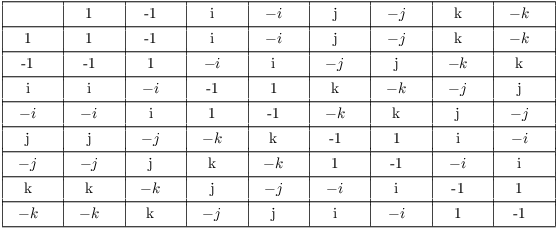
To show that the subgroup is normal, I have to compute ![]() for each element g in the group
and show that I always get the subgroup
for each element g in the group
and show that I always get the subgroup ![]() .
.
It's a bit tedious to do this for all the elements, so I'll just do the computation for one of them by way of example.
Take ![]() . Then
. Then ![]() (since
(since ![]() ), so
), so
![]()
![]()
This is the same set as the original subgroup, so the verification worked with this element.
If I do the same computation with the other elements in Q, I'll
always get the original subgroup back. Therefore, ![]() is normal.
is normal.![]()
As this example indicates, it is generally infeasible to show a subgroup is normal by checking the definition for all the elements in the group!
Here's another special case where subgroups satisfying a certain condition are normal.
Proposition. Let H be a subgroup of G. If ![]() , then H is normal.
, then H is normal.
Proof. Since ![]() , I know that
H has two left cosets and two right cosets. One coset is always H
itself. Take
, I know that
H has two left cosets and two right cosets. One coset is always H
itself. Take ![]() . Then
. Then ![]() is the other left coset,
is the other left coset, ![]() is the other right coset, and
is the other right coset, and
![]()
But these are disjoint unions, so ![]() , and therefore
, and therefore
![]() . This equation holds for any g in the
coset
. This equation holds for any g in the
coset ![]() . The equation clearly holds for any
element of the trivial coset H. Hence, the equation holds for all
elements of G, and H is normal.
. The equation clearly holds for any
element of the trivial coset H. Hence, the equation holds for all
elements of G, and H is normal.![]()
Example. Show that the alternating group ![]() is a normal subgroup of
is a normal subgroup of ![]() .
.
The even permutations make up half of ![]() , so
, so ![]() . Therefore,
. Therefore, ![]() is normal.
is normal.![]()
Example. ( Checking normality in a product) Let G and H be groups. Let
![]()
Prove that ![]() is a normal subgroup of the
product
is a normal subgroup of the
product ![]() .
.
First, I'll show that it's a subgroup.
Let ![]() , where
, where ![]() . Then
. Then
![]()
Therefore, ![]() is closed under products.
is closed under products.
The identity ![]() is in
is in ![]() .
.
If ![]() , the inverse is
, the inverse is ![]() , which is in
, which is in ![]() .
.
Therefore, ![]() is a subgroup.
is a subgroup.
To show that ![]() is normal, let
is normal, let ![]() , where
, where ![]() and
and ![]() . I must show that
. I must show that
![]()
I can show one set is a subset of another by showing that an element
of the first is an element of the second. An element of ![]() looks like
looks like ![]() , where
, where ![]() . Now
. Now
![]()
![]() , since
, since ![]() . Therefore,
. Therefore,
![]() . This proves
that
. This proves
that ![]() . Therefore,
. Therefore, ![]() is
normal.
is
normal.![]()
Now I need to show that the condition of normality allows me to turn the set of cosets of a subgroup into a quotient group under coset multiplication or addition. I need a few preliminary results on cosets first.
Theorem. Let G be a group, and let H be a subgroup of G. The following statements are equivalent:
(a) a and b are elements of the same coset of H.
(b) a H = b H.
(c) ![]() .
.
Proof. To show that several statements are equivalent, I must show that any one of them follows from any other. To do this efficiently, I'll show that statement (a) implies statement (b), statement (b) implies statement (c), and statement (c) implies statement (a).
((a) ![]() (b)) Suppose a and b are elements of the
same coset
(b)) Suppose a and b are elements of the
same coset ![]() of H. Since
of H. Since ![]() , and since cosets are either disjoint or
identical,
, and since cosets are either disjoint or
identical, ![]() . Likewise,
. Likewise, ![]() implies
implies ![]() . Therefore,
. Therefore,
![]() .
.
((b) ![]() (c)) Suppose
(c)) Suppose ![]() . Since
. Since ![]() , it follows that
, it follows that ![]() . Therefore,
. Therefore, ![]() for some
for some ![]() . Hence,
. Hence, ![]() .
.
((c) ![]() (a)) Suppose
(a)) Suppose ![]() . Then
. Then ![]() , so
, so
![]() . Therefore, a and b are elements of the
same coset of H, namely
. Therefore, a and b are elements of the
same coset of H, namely ![]() .
.![]()
Corollary. ![]() if and only if
if and only if
![]() .
.
Proof. The equivalence of the second and third
conditions says that ![]() if and only if
if and only if ![]() . Taking
. Taking ![]() , this says that
, this says that
![]() if and only if
if and only if ![]() , which is what I
wanted to prove.
, which is what I
wanted to prove.![]()
Now I'll show that the definition of normality does what I wanted it to.
Theorem. Let G be a group, ![]() . The following statements are equivalent:
. The following statements are equivalent:
(a) ![]()
(b) For all ![]() ,
, ![]() . (Thus, every left coset is a right coset and every
right coset is a left coset.)
. (Thus, every left coset is a right coset and every
right coset is a left coset.)
(c) Coset multiplication is well-defined.
By (c), I mean that if ![]() and
and ![]() , then
, then ![]() .
Once I know that multiplication is well-defined, I can define
multiplication of cosets by
.
Once I know that multiplication is well-defined, I can define
multiplication of cosets by ![]() .
.
Proof. ((a) ![]() (b)) If
(b)) If ![]() and
and ![]() , then
, then ![]() , so
, so ![]() , or
, or
![]() .
.
((b) ![]() (c)) Suppose
(c)) Suppose ![]() for all
for all ![]() . Suppose
. Suppose
![]()
Then
![]()
((c) ![]() (a)) Suppose coset multiplication is well
defined. I want to show
(a)) Suppose coset multiplication is well
defined. I want to show ![]() . Let
. Let ![]() . I will show
. I will show ![]() .
.
Let ![]() . I will show
. I will show ![]() .
.
By an earlier result, ![]() , and surely
, and surely ![]() , so (since coset multiplication is well-defined)
, so (since coset multiplication is well-defined)
![]()
And since ![]() ,
,
![$$\eqalign{ [(g h) H] (g^{-1} H) & = (g H)(g^{-1} H) \cr (g h g^{-1}) H & = (g g^{-1}) H \cr (g h g^{-1}) H & = H \cr}$$](normal-subgroups163.png)
An earlier result shows that this implies ![]() . Therefore,
. Therefore, ![]() .
.![]()
The point of all this was to make the set of cosets ![]() into a group via coset multiplication or addition.
into a group via coset multiplication or addition.
Theorem. If ![]() , the
set of left cosets
, the
set of left cosets ![]() becomes a group under coset
multiplication.
becomes a group under coset
multiplication.
Proof. I'll check that axioms. For associativity, note that
![]()
I have
![]()
Hence, ![]() is the identity for coset multiplication.
is the identity for coset multiplication.
Finally
![]()
Therefore, ![]() , and every coset has
an inverse.
, and every coset has
an inverse.![]()
Definition. Let G be a group, and let ![]() . The set
. The set ![]() of left cosets under
coset multiplication is the quotient group (or
factor group) of G by H.
of left cosets under
coset multiplication is the quotient group (or
factor group) of G by H.
Because coset multiplication (or addition) is independent of the choice of representatives, you do computations in quotient groups by doing the corresponding computations on coset representatives. The following examples illustrate this idea.
Example. ( Adding
cosets) Let ![]() and let H be the subgroup
and let H be the subgroup ![]() .
.
(a) List the cosets of ![]() .
.
(b) Construct the addition table for the quotient group ![]() using coset addition as the
operation.
using coset addition as the
operation.
(c) Identify the quotient group as a familiar group.
(a) The cosets of H are
![]()
(b) Make the set of cosets ![]() into a group by using coset
addition. This means that to add two cosets you add their
representatives, then take the coset containing the sum as the sum of
the cosets. Here's the addition table:
into a group by using coset
addition. This means that to add two cosets you add their
representatives, then take the coset containing the sum as the sum of
the cosets. Here's the addition table:

To see how the table was constructed, consider the entry
![]()
Use representatives for the cosets:
![]()
You add cosets by adding their representatives --- in this
case, 2 and 3 --- and attaching the sum to the subgroup --- in this
case, ![]() :
:
![]()
You can also use individual elements. Take an element from ![]() and an element from
and an element from ![]() and add them. Find the coset that contains the sum.
That coset is the sum of the cosets.
and add them. Find the coset that contains the sum.
That coset is the sum of the cosets.
For example, if I use 6 from ![]() and 3 from
and 3 from ![]() , I get
, I get ![]() , which is in
, which is in ![]() . Therefore,
. Therefore, ![]() .
.
What happens if you choose different elements? Take 2 from ![]() and 7 from
and 7 from ![]() . Then
. Then ![]() , which is in
, which is in ![]() again. Just as
before,
again. Just as
before, ![]() .
.
This is what it means to say that coset addition is well-defined:
No matter which elements you choose from the two sets, the sum of the
elements will always be in the same coset.![]()
(c) The table above is a group table for a group of order 4. There
are only two groups of order 4: ![]() and
and ![]() . Hence, the group above must be
isomorphic to one of these groups. Replace
. Hence, the group above must be
isomorphic to one of these groups. Replace
![]()
This gives the table:
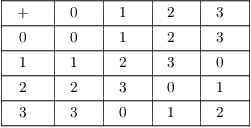
Thus, ![]() .
.![]()
Example. The cosets of the subgroup ![]() in
in ![]() are
are

(a) Compute ![]() .
.
(b) Compute ![]() .
.
(c) Compute ![]() .
.
(d) Construct a multiplication table for the quotient group ![]() . Determine whether the
quotient group is isomorphic to
. Determine whether the
quotient group is isomorphic to ![]() or to
or to ![]() .
.
(a) Take an element (it doesn't matter which one) from each coset,
say ![]() and
and ![]() .
.
Perform the operation on the elements you chose. In this case, it's multiplication:
![]()
Find the coset containing the answer: ![]() .
.
Hence,
![]()
(b) Take an element (it doesn't matter which one) from the coset, say
![]() .
.
Perform the operation on the elements you chose. In this case, it's finding the inverse (use the Extended Euclidean Algorithm, or trial and error):
![]()
Find the coset containing the answer: ![]() .
.
Hence,
![]()
(c) Take an element (it doesn't matter which one) from the coset, say
![]() .
.
Perform the operation on the elements you chose. In this case, it's cubing:
![]()
Find the coset containing the answer: ![]() .
.
Hence,
![]()
(d) To save writing, I'll use ![]() ,
, ![]() ,
, ![]() , and
, and ![]() to represent the cosets. I did the multiplications to
construct the table the way I did the multiplication in (a) above.
to represent the cosets. I did the multiplications to
construct the table the way I did the multiplication in (a) above.
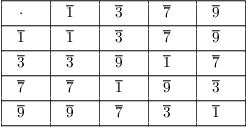
I can see that ![]() has order 4. Therefore,
has order 4. Therefore, ![]() .
.![]()
Example. The cosets of ![]() in
in ![]() are
are

(a) Compute ![]() .
.
(b) Construct an addition table for the quotient group ![]() . Determine whether the quotient group is isomorphic
to
. Determine whether the quotient group is isomorphic
to ![]() or to
or to ![]() .
.
(a) Take an element (it doesn't matter which one) from the cosets,
say ![]() and
and ![]() . (I'll just use the coset
representatives, but again, I could choose any elements from the two
cosets.)
. (I'll just use the coset
representatives, but again, I could choose any elements from the two
cosets.)
Perform the operation on the elements you chose. In this case, it's addition:
![]()
Find the coset containing the answer:
![]()
Hence,
![]()
(b) To save writing, I'll use ![]() ,
, ![]() ,
, ![]() , and
, and ![]() to represent the cosets. I did the additions to
construct the table the way I did the addition in (a) above.
to represent the cosets. I did the additions to
construct the table the way I did the addition in (a) above.
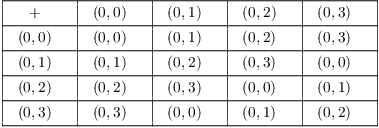
I can see that ![]() has order 4, so
has order 4, so
![]() .
.![]()
Example. ( A quotient group
of a dihedral group) This is the table for ![]() , the group of symmetries of an equilateral triangle.
, the group of symmetries of an equilateral triangle.
![]() is rotation through
is rotation through ![]() ,
, ![]() is rotation through
is rotation through
![]() , and
, and ![]() ,
, ![]() , and
, and ![]() are reflections through the
altitude through vertices 1, 2, and 3, respectively.
are reflections through the
altitude through vertices 1, 2, and 3, respectively.
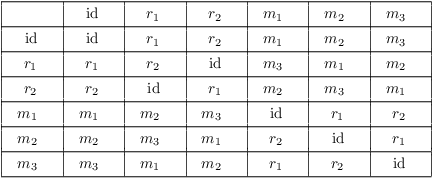
(a) Show that the rotation subgroup ![]() is a normal subgroup of
is a normal subgroup of ![]() .
.
(b) Construct the multiplication table for the quotient group ![]() and identify the quotient group as a familiar group.
and identify the quotient group as a familiar group.
(c) Consider the subgroup ![]() . Show that
. Show that ![]() is not normal in
is not normal in ![]() .
.
(a) Since H has 3 elements, it has index ![]() , so it must be normal.
, so it must be normal.
You can check this directly but tediously by checking that ![]() for each
for each ![]() . For example,
. For example,
![]()
And so on for the other elements.
It's also possible to show it's normal geometrically, by reasoning
about orientation.![]()
(b) ![]() is a group with two elements:
is a group with two elements:
![]()
Here is the group table for ![]() :
:

Up to notation, this is "the" group of order 2, namely ![]() .
.![]()
(More generally, consider the group ![]() of symmetries of the regular n-gon. This group has a
subgroup of rotations H consisting of rotations through the angles
of symmetries of the regular n-gon. This group has a
subgroup of rotations H consisting of rotations through the angles
![]() , where
, where ![]() . This
subgroup is normal, since it has index 2. To see this geometrically,
observe that if
. This
subgroup is normal, since it has index 2. To see this geometrically,
observe that if ![]() is a rotation and
is a rotation and ![]() is also a rotation,
is also a rotation, ![]() is obviously a rotation. On the other hand,
suppose
is obviously a rotation. On the other hand,
suppose ![]() is a reflection. Then
is a reflection. Then ![]() is orientation-preserving, so it must also
be a rotation.)
is orientation-preserving, so it must also
be a rotation.)
(c) I must find a ![]() such that
such that ![]() . Here's an example:
. Here's an example:
![]()
Another way to prove that the subgroup isn't normal is to compare the left and right cosets. The left cosets are
![]()
The right cosets are
![]()
As you can see, the left and right cosets are not the same.![]()
Remember that when a subgroup is normal, there is a well-defined multiplication on the set of cosets of the subgroup. Let's see how this works out for the two subgroup I discussed above.
The first table below is the multiplication table for ![]() , the group of symmetries of a triangle. The subgroup
, the group of symmetries of a triangle. The subgroup
![]() has two cosets: H itself and the
set
has two cosets: H itself and the
set ![]() . Notice that the row and column
headings have been set up with the two cosets one after another.
. Notice that the row and column
headings have been set up with the two cosets one after another.
Get out your coloring pencils! Color the two cosets in the table
below in such a way that all the elements of a given coset are the
same color, and different cosets have different colors. For example,
leave the elements of ![]() uncolored and
color the elements
uncolored and
color the elements ![]() green.
green.
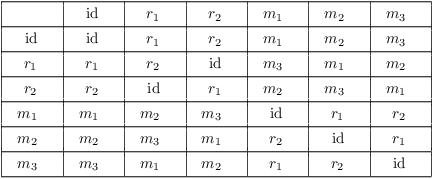
Consider the product of two elements ![]() . The coloring shows that the coset containing the
product depends only on the cosets containing a and b. Suppose
. The coloring shows that the coset containing the
product depends only on the cosets containing a and b. Suppose ![]() is in the coset colored green. Take
is in the coset colored green. Take ![]() in the same coset as a and
in the same coset as a and ![]() in the same coset as b. Then
in the same coset as b. Then ![]() will also be in the coset colored green. This proves
that you can multiply cosets by multiplying coset representatives and
get a well-defined multiplication.
will also be in the coset colored green. This proves
that you can multiply cosets by multiplying coset representatives and
get a well-defined multiplication.
Here is the same table rearranged to fit the non-normal subgroup ![]() and its cosets
and its cosets ![]() and
and ![]() .
Color the elements of the three cosets with different colors as in
the last example.
.
Color the elements of the three cosets with different colors as in
the last example.
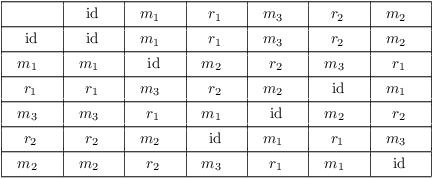
In this case, the coset containing a product ![]() depends on the particular elements a and b, not just
on the cosets containing a and b. The coloring produces a table
that is not arranged in nice "blocks" like the previous
table. For example,
depends on the particular elements a and b, not just
on the cosets containing a and b. The coloring produces a table
that is not arranged in nice "blocks" like the previous
table. For example, ![]() , which
is in the third coset. On the other hand,
, which
is in the third coset. On the other hand, ![]() , which is in the first coset. You get
different cosets, even though the factors in the two products are all
in the second coset. In this case, coset multiplication by
multiplication of representatives is not well-defined.
, which is in the first coset. You get
different cosets, even though the factors in the two products are all
in the second coset. In this case, coset multiplication by
multiplication of representatives is not well-defined.![]()
It is natural to see how a new construction interacts with things like unions and intersections. Since the union of subgroups is not a subgroup in general, it's unreasonable to expect a union of normal subgroups to be a normal subgroup. However, intersections work properly.
Proposition. The intersection of a family of normal subgroups is a normal subgroup.
Proof. Let G be a group, and let ![]() be a family of normal subgroups of G. Let
be a family of normal subgroups of G. Let
![]() . I want to show that
. I want to show that ![]() . Since the intersection of a family of
subgroups is a subgroup, it remains to show that H is normal.
. Since the intersection of a family of
subgroups is a subgroup, it remains to show that H is normal.
Let ![]() and let
and let ![]() . I must show
. I must show ![]() . Now
. Now ![]() implies
implies ![]() for all a, so (since
for all a, so (since ![]() for all a)
for all a) ![]() for all a. Therefore,
for all a. Therefore, ![]() . Therefore, H is
normal.
. Therefore, H is
normal.![]()
Definition. Let G be a group, and let ![]() . The intersection of all normal subgroups of G
containing S is the normal subgroup generated
by S.
. The intersection of all normal subgroups of G
containing S is the normal subgroup generated
by S.
Why are normal subgroups and quotient groups important? The idea is
that you might be able to understand groups by taking them apart into
pieces, the way that you can factor a positive integer into a product
of primes. If you're trying to understand a group G, you try to find
a normal subgroup H. This allows you to decompose G into smaller
groups H and ![]() . Now you try to find normal subgroups of H
and of
. Now you try to find normal subgroups of H
and of ![]() , and you keep going.
, and you keep going.
At some point, you may be unable to find any normal subgroups (other
than ![]() and the group itself).
and the group itself).
Definition. A group G is
simple if its only normal subgroups are ![]() and G.
and G.
Thus, simple groups are to groups as prime numbers are to positive integers.
Proposition. Let ![]() . Then n is prime if and only if
. Then n is prime if and only if ![]() is simple.
is simple.
Proof. Suppose n is prime. The order of a
subgroup must divide the order of the group (by Lagrange's theorem),
and the only positive divisors of n are 1 and n. Therefore, the only
subgroups --- and hence the only normal subgroups --- are ![]() and
and ![]() . Therefore,
. Therefore,
![]() is simple.
is simple.
Suppose n is composite. Then there is an integer m such that ![]() and
and ![]() . Since
. Since ![]() is cyclic, it has a subgroup with m elements; since
is cyclic, it has a subgroup with m elements; since
![]() is abelian, that subgroup must be normal.
Since
is abelian, that subgroup must be normal.
Since ![]() has a normal subgroup other than
has a normal subgroup other than ![]() and
and ![]() , it is not
simple.
, it is not
simple.![]()
The hope is that if you know all the possible simple groups, and you know all the ways of putting them together, then you'll know all about groups. In its complete generality, this ideal is unattainable. However, progress has been made in this endeavor for finite groups. The finite simple groups were completely classified around 1980; estimates suggested that the complete proof (pieces of which were finished by many people over the course of decades) ran to thousands of pages.
There is a fundamental relationship between kernels of group maps and normal subgroups; in fact, normal subgroups are exactly the kernels of group maps. The first part of the next result proves part of this assertion.
Proposition. Let ![]() be a group homomorphism.
be a group homomorphism.
(a) ![]() .
.
(b) If ![]() , then
, then ![]() .
.
Proof. (a) I showed earlier that ![]() is a subgroup of G. So I only need to show that
is a subgroup of G. So I only need to show that ![]() is normal. Let
is normal. Let ![]() (so
(so ![]() ) and let
) and let ![]() . I need to show that
. I need to show that ![]() .
.
![]()
Hence, ![]() , and
, and ![]() .
.
(b) I showed earlier that ![]() is a subgroup
of G. I only need to show that if
is a subgroup
of G. I only need to show that if ![]() is normal in H, then
is normal in H, then
![]() is normal in G.
is normal in G.
Let ![]() , so
, so ![]() , and let
, and let ![]() . I must show that
. I must show that ![]() . Apply f and see if it winds up
in
. Apply f and see if it winds up
in ![]() .
.
![]()
(The last inclusion follows from normality of ![]() .) Hence,
.) Hence, ![]() , and
, and
![]() .
. ![]()
Remarks. (a) It's not true in general that the image of a normal subgroup is normal. It is true if the map is a surjection. (Try it yourself!)
(b) The lemma above says that kernels of group maps are normal
subgroups. In fact, the converse is true, and I'll prove it later:
Every normal subgroup is the kernel of a group map.![]()
Copyright 2018 by Bruce Ikenaga